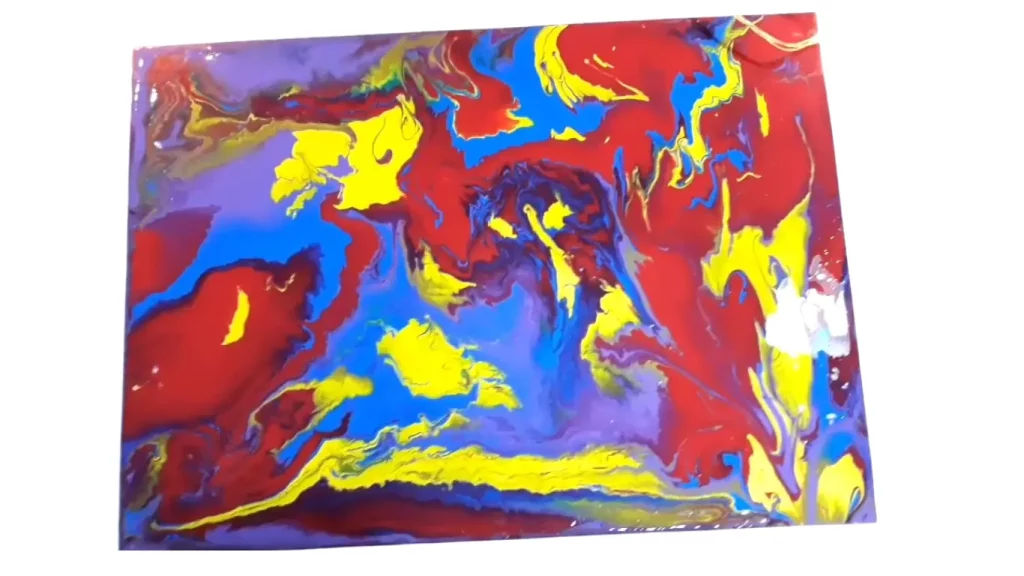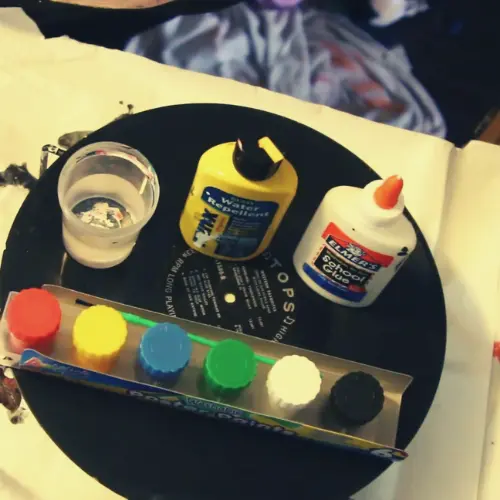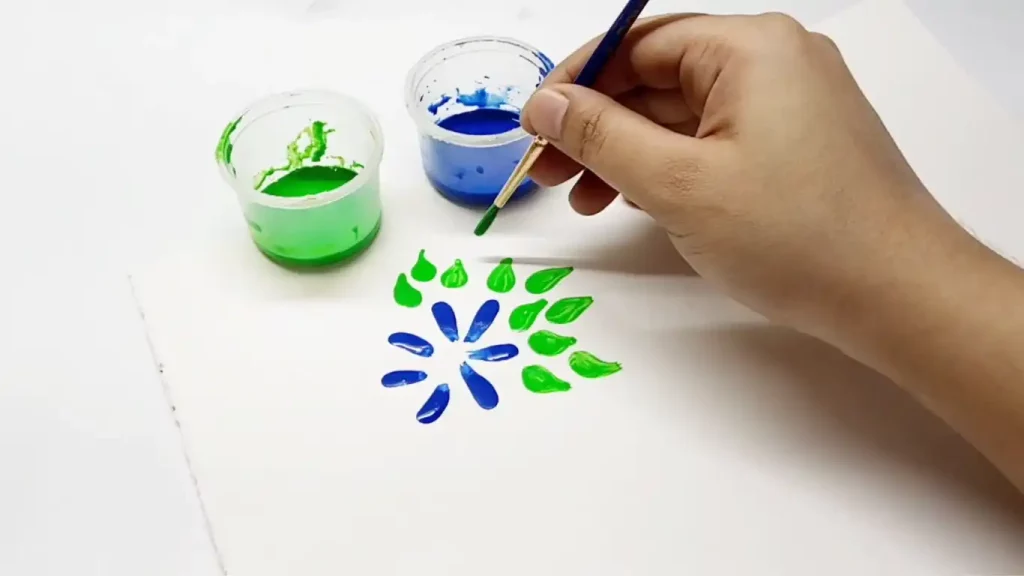Poster paint is a water-based paint that is available in most craft stores. It is inexpensive and comes in a variety of colors. Poster colors are typically used for paper and paper boards, school art projects, and craft projects. You can also use poster paint on polymer clay and terracotta pots. You may wonder if you can use it for paint pouring. So, can you use poster paint for paint pouring?
You can use Poster paint for paint pouring, but to get the best out of Poster paint for using it as paint pouring, you need to prepare it well before painting. It will not give you the same results as using acrylic paint. Because Poster paint is thinner than acrylic paint and will not produce as many cells or as much color variation.

Can Poster Paint Be Used As Pouring Paint?
Poster paint is a versatile product that can be used for many different types of painting projects. One popular use for poster paint is pouring paintings. Pouring paintings are created by pouring thinned-out poster paint onto a canvas, paper, or other surfaces.
The paint then runs and creates interesting patterns. Pouring paint is a great way to create abstract artwork. You can experiment with different color combinations and pour techniques to create unique art pieces.
If you’re new to pouring paintings, start with a small project so you can get a feel for how the paint behaves. Once you’ve mastered the basics, you can move on to larger projects. To create a pouring painting, start by thinning out your Poster paint with water.
If you want to add a pouring medium with poster paint, use a one-part pouring medium with one-part of poster paint. Too much pouring medium will chip and peel the paint from the surface when the paint dries.
As poster paint is thinner than acrylic paint and it’s not permanent, you can add a little bit of PVA glue into the paint so that the paints bind better. This will also enhance the paints’ durability.
You’ll want to use a ratio of 1 part poster paint to 2 parts water. Mix the Poster paint and water together until it’s completely combined. Consider checking the consistency of the paint. If it is too thin, add more paint and if it is too thick, add water until you get the consistency of chocolate syrup or motor oil. Then, pour the mixture onto your canvas or other painting surfaces.
You can use different pouring techniques to create different effects. For example, try dripping the paint from a spoon or using a squeeze bottle to control the flow of the paint. Once you’ve poured your desired amount of paint onto the surface, tilt the canvas or surface around so that the paint runs and mixes together.
Create as much or as little movement as you like – it’s up to you!
How to Thin Poster Paint for Pouring
Paint pouring is a fun and easy way to create beautiful works of art. However, if your paint is too thick, achieving the desired results cannot be easy. Fortunately, you can use a few simple techniques to thin your paint for pouring.
One method is to add a small amount of water to your paint. Start with just a few drops and mix well. Add more water as needed until you reach the desired consistency.
Another option is to add a flow medium such as Liquitex Pouring Medium or Golden Open Acrylic Flow Improver. These products help to thin the paint and promote smooth flow and leveling. Add them according to the package directions.

Once you have thinned your paint, it’s time to start pouring! Experiment with different techniques and enjoy watching your colors come alive on the canvas!
Pouring Medium to Paint Ratio
There are many different ways to pour paint, but one of the most important things to consider is the ratio of paint to the pouring medium. This ratio will determine how your paint flows and how it dries.
Too much paint and your piece will be heavy and opaque. Too little paint and your piece will be light and translucent. The best way to achieve the perfect ratio is to experiment with different ratios and see what works best for you. A good starting point is 1 part paint to 1 part pouring medium. From there, you can adjust as needed until you find the perfect balance for your project.
Is It Okay to Use Poster Paint on Canvas?
Poster paint is a type of paint that is often used for creating posters and other marketing materials. It is typically made from a combination of glue, starch, and pigment and can be applied to various surfaces, including canvas. While poster paint can be used on canvas, it is important to note that it is not the same as artist-grade acrylic paint.
Poster paint is not as durable as artist-grade acrylic and may not stand up to the same level of scrutiny when being examined closely. Additionally, poster paint may not adhere as well to canvas over time, particularly if it is exposed to sunlight or other sources of heat. For these reasons, it is generally recommended that artists use artist-grade acrylics when painting on canvas.

Can You Use Any Paint for Paint Pouring?
Yes, you can use more or less any paint for paint pouring, but some paints work better than others. High flow or fluid acrylics are the best types of paint to use for pour painting because they dry quickly and don’t require much prep work. However, you can also use emulsion paint, latex paints, or even oils if you’re willing to put in a little more effort to prepare them.
How to Make Poster Paint into Acrylic Paint
Poster paint is a type of paint that is usually made from water-soluble binders. However, you can also make Poster paint into acrylic paint. To do this, you will need to add an acrylic resin to the poster paint.
To make Poster paint more durable and long-lasting, add a little bit of PVA glue and a splash of hand-rubbing alcohol into the paint. The glue will help the paint bind a little better, and the alcohol will make the paint drippy and runny by lessening the thickness.
This will make the poster paint more durable and longer lasting. It will also make it more resistant to fading and chipping.

Can You Use Pouring Paint As Regular Paint
Pouring paint is a type of acrylic paint that is thinner and more fluid than regular acrylic paint. It is designed to be used in a pouring technique where the paint is poured onto the surface rather than brushed on. Pouring paint can be mixed with other colors to create interesting effects, or it can be used on its own to produce a marbled or tie-dye appearance.
It dries quickly, so you’ll need to work fast when using this type of paint. Pouring paint can be applied to a variety of surfaces, including canvas, wood, metal, and glass. You’ll need to prime your surface before painting if you’re using an absorbent material like canvas.
Once the pour painting is dry, it’s important to seal it with a varnish or resin to protect the finish.
What is the Best Paint to Use for Pour Painting?
Paint pouring is a relatively new technique that has taken the art world by storm. This fluid painting method involves pouring paint onto a surface to create beautiful, one-of-a-kind pieces of art. While there are many different brands and types of paint that can be used for paint pouring, not all paints are created equal.
So, what is the best house paint for acrylic pouring? The short answer is that any type of artist-grade acrylic fluid paint will work well for pour painting. However, there are certain characteristics that make some paints better than others.
When choosing paint for your next project, look for a brand that offers high-quality pigments and flow control additives. These ingredients will help you achieve smooth, even pours every time. Another important factor to consider is drying time.
Acrylics dry quickly, so you’ll want to choose a paint that dries at a reasonable rate. This way, you can avoid any unwanted smudging or streaks in your final product.
Finally, don’t forget about color! Acrylic pour paintings are known for their vibrant hues and bold patterns. To get the most out of your pour painting experience, choose colors that complement each other and produce interesting visual effects when mixed together.
Oil-based paints are another possibility for pour painting. They’re not as common as acrylic paints, but they have their own advantages. Oil-based paints take longer to dry than other types of paint, which gives you more time to work with them.
Some artists like to use a limited palette of just two or three colors, while others prefer to experiment with a wide range of hues. Ultimately, what colors you use is up to you – just have fun with it!
Conclusion
Yes, now you know that you can use Poster paint for paint pouring. However, poster paint is not the ideal type of paint to use for this technique. Poster paint is not as viscous as other types of paint, so it will not flow well and may produce a less desirable result. But poster paint is inexpensive and also available in craft shops. So, it’s a good go if you want to paint this paint to use as a paint pouring. However, make sure to prepare the paint well before start painting.

S. Pushon is a paint expert, self-taught artist, and currently working as an adviser in the paint industry as a Quality Improvement and Development Assistant.
An artist by heart, he draws remarkable art pieces and as a professional paint industry individual, he seeks the insight and shares with enthusiasts. Read more…

